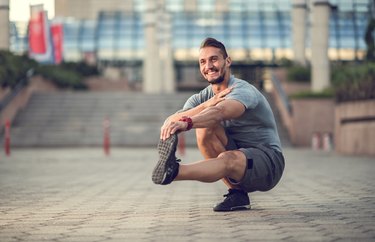
Performing squats as a part of your weekly exercise routine can help keep your lower-body muscles strong. And doing them on one leg (aka pistol squats) can build better balance, coordination and speed for running and other athletic activities.
Single-leg squats work most major muscle groups in the lower body and encourage greater core strength.
Video of the Day
Muscles Used for Single-Leg Squats
One-legged squats work the same primary muscle groups used for running, including:
- Hips
- Hamstrings
- Quadriceps
- Gluteal muscles
- Calves
Hamstrings are located at the back of the upper leg and quadriceps are in the front part of the upper leg. Gluteal muscles, also referred to as buttocks muscles, attach to your hamstrings from above. Calves consist of the soleus and the gastrocnemius muscles and are located at the back of your lower legs.
Supportive muscles used during single-leg squats include the upper and lower abdominals and biceps. Because the exercise relies on your abdominal and gluteal muscles for balance, performing one-legged squats regularly can help tone and strengthen your midsection while building leg strength.
This translates to better movement and coordination during sports performance and other activities, especially when combined with other cross-training exercises, such as high-bench step-ups and one-legged hops.
How to Do a Single-Leg Squat
- Root your right foot into the ground.
- Keeping your left leg as straight as possible, raise it off the floor, hovering in the air.
- Slowly squat down on your right leg, pushing your hips back.
- Lower until just before your left heel reaches the ground.
- Reverse the motion slowly and return to standing.
Related Reading
Other Benefits of One-Legged Squats
One-legged squats, when part of a regular routine, can help you build better balance, coordination and body awareness. For instance, one-legged squats may help you balance long enough to put on a sock without having to sit in a chair or grab onto an object for support.
One-legged squats teach your body to balance in a manner similar to the exercises commonly practiced in martial arts for rooting, which refers to the way a tree is rooted to the ground. The body is challenged to balance over a narrow base of support during one-legged squats and must find a center of gravity and connection to the ground.
The neuromuscular system is also challenged because of the combined skills involved in balancing, stretching and coordinating during the exercise.
The one-legged squat builds power and stability. One-legged squats have real-world implications because the range of motion activity involved in the exercise best mimics common muscle movements performed in sports, as well as in daily activities.
One-legged squats better prepare your body for the rigors of athletic performance, including running, jumping and the sudden turns and twists commonly found in many sports. Whereas two-legged squats can cause muscle imbalances between legs because one leg tends to lead, single-legged squats help each leg develop and strengthen separately and equally. The combined skills involved in performing one-legged squats help develop flexibility, endurance and coordination.